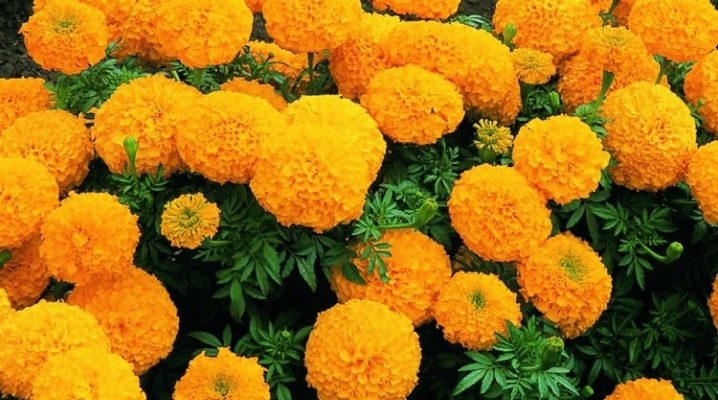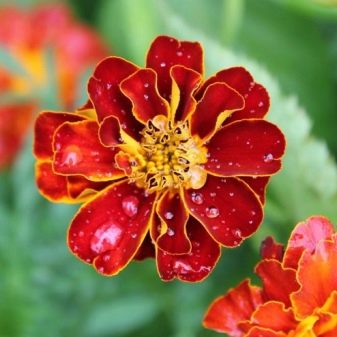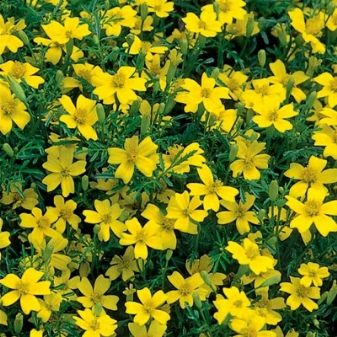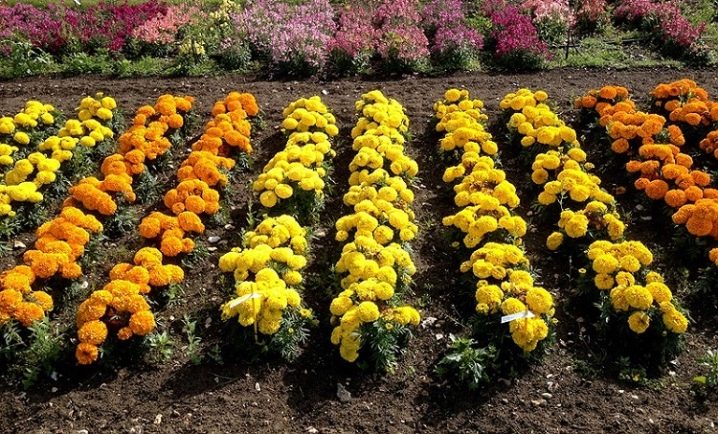Varieties of large-flowered marigolds and their cultivation

Marigolds are incredibly beautiful and voluminous flowers. Even a few flowers can be beneficial to complement any flower bed and give it more volume. They look just as great in vases and bouquets. Once upon a time, marigolds were only one species, but today, thanks to the work of breeders, there is a huge abundance of different varieties for every taste and color. You can easily find beautiful color combinations to bring your wildest garden design fantasies to life. We will talk about what marigolds are, and how to properly care for them, and we will talk in this article.

Varieties
Surely everyone knows what this flower looks like. Most often, small-flowered marigolds are found (about 20-30 centimeters), however, the growth of certain varieties can reach 120 centimeters. There are also dwarf marigolds, the size of the stems of which is only 15 centimeters.
In addition, they can vary in color. Most marigolds have yellow, orange or brown flowers, but there are also varieties with bright red and even white buds. You can also find variegated marigolds, in which the petals are painted in several colors at once.
Marigold inflorescences can vary quite a bit in shape. In total, there are three types of them.

Non-double (simple)
Marigolds are called simple, in the inflorescence of which there are from one to three rows of petals. Such varieties are somewhat reminiscent of multi-colored daisies, and have a large orange receptacle with reed petals growing along its contour.

Semi-double
In semi-double varieties, the petals cover slightly less than 50 percent of the inflorescence.

Terry
Marigolds are called terry, in which petals cover more than 50 percent of the inflorescence. Outwardly, they look like a solid ball of petals. In turn, they are divided into three more subspecies, depending on the type of their petals.
- Anemone... Reed petals run along the edges of the inflorescence, and tubular petals are located in the center.
- Carnation... Consist only of reed petals.
- Chrysanthemum... They consist only of tubular petals.
This diversity helps a lot in arranging the garden, because the same flower is suitable for completely different compositions, you just need to choose the right varieties.

Varieties
As mentioned earlier, today quite a few different varieties of marigolds have been bred. In total, at the moment, there are more than 50 of their varieties. The most popular are terry undersized varieties of marigolds with large flowers. Such flowers look very luxuriant and give the flowerbed (or the house) additional comfort. The following varieties are most popular with us.
- "Vilmorin". The most popular variety. Its flowers look like small yellow bows, and the stems grow up to 26 centimeters.

- "Cherry bracelet". Marigolds of this variety grow in small dense bushes, the height of which does not exceed 25 centimeters. This variety got its name for the flowers, which can be bright red or dark cherry hue.


- Gold Cophen. This variety also grows as small, dense bushes up to 25 centimeters high and very dense foliage. These are large-flowered marigolds with terry inflorescences of golden hues.

- "Golden ball". The bushes of this variety are famous for their beauty. They grow up to 30 centimeters and have very colorful terry branches, on the tops of which there are large golden flowers, shaped like pads.

- Carmen. And this is one of the representatives of variegated marigolds. The flowers of this variety are painted in two colors at once, in the middle they are bright yellow, and at the edges they have a darker red-brown tint. Their bushes are very spreading and grow up to 30 centimeters.


- "Queen Sofia". We can say that this variety is the opposite of Carmen. Its bushes are very dense, and the flowers, on the contrary, have a dark burgundy center and yellow edges.

- "Orange Flame". A short, dense bush with dense foliage and semi-double orange flowers.

- "Dwarf". Small bushes, no more than 25 centimeters high, with spherical dark orange buds.

- Lulu. This variety is famous for its dense flowering. It is a large and sprawling bush with very neat thin leaves and small inflorescences of a bright yellow hue.


Very often, low varieties of marigolds are combined with other flowers. For example, they will look great in the same flower bed with petunias or brachycomas. In addition, they are also used as curb plants to frame a flower bed.
But do not think that only undersized marigolds are popular. Taller marigolds are very often used to build beautiful compositions in personal plots. They can easily be the main decoration of your flower bed, taking place in the very center of it. The most popular are the following varieties of tall marigolds.
- Gelber Stein. Relatively short bushes that can grow up to 70 centimeters. In shape and size of the inflorescence, they resemble a light golden chrysanthemum.


- Gold Dollar. One of the highest grades. The height of this bush can reach 120 centimeters. Its shoots are very powerful and strong, with large rich green leaves. The flowers are similar to a carnation, but much larger (the average diameter of the inflorescence is 7 centimeters).


- Goldlicht. Also a fairly tall variety with a powerful stem. A distinctive feature of this variety is its large flowers (the diameter of one inflorescence can reach 10 centimeters), which look like an orange hemisphere.

As you can see, higher varieties of marigolds can be quite diverse. You can easily find seeds of any of the varieties listed above on the flower market.
This means that you are only a couple of steps away from creating the perfect flower bed.

How to take care of it properly?
Marigolds are considered quite unpretentious flowers; they do not require any special conditions or approach. However, when growing them, you still need to adhere to certain rules.
Marigolds are very fond of light, these are one of the few flowers that need to be planted in direct sunlight. The more light they receive, the more magnificent and brighter they will bloom. The correct temperature level is also very important for plants. These flowers love warmth, room temperature will be optimal for them, but it can be higher. The main thing is that the plant does not freeze. Marigolds can only be planted in late spring.
The fact that the temperature is too low can be understood by the appearance of the flower.

Marigolds are quite unpretentious in terms of soil selection, however, they will grow best on dense soil rich in nutrients. It will also be useful to loosen the soil from time to time so that it better allows water and air to pass through. Flowers are very fond of water, but with an excess of it, they are prone to decay of the roots. Therefore, they need to be watered often, but not very abundantly.
In no case plant marigolds in the lowlands, as there they will most likely be flooded during the first heavy rain. Also, do not plant them in places of possible occurrence of groundwater, for the same reason.
Marigolds can grow safely without fertilization, but if you have the opportunity, you can feed them from time to time. But do not overdo it, plants can react negatively to too frequent feeding.The first time the flowers need to be fed when their height reaches ten centimeters, then when the first buds appear and, finally, they are fed for the last time just before flowering.
If you grow marigolds at home, then fertilizers need to be applied much more often (about twice a month).


Main problems
Marigolds are very beautiful and not capricious flowers. But under certain circumstances, the plant can become a victim of pests or diseases.
If the soil in which the flower grows is constantly damp, then its the roots can rot very quickly. In addition, excessive dampness can lead to the appearance of fungus, as well as lure snails and slugs.
The most common type of fungus that infects marigolds is called blackleg. You can understand that the plant has been infected by the white spots on its stem. If you notice signs of infection, then the plant should be removed as soon as possible, and the place where it grew should be treated with fungicides, ash and perlite. Another common disease is root rot. This disease can be recognized by the yellowness on the leaves and stem of marigolds.
It is impossible to save the plant from it, the procedure is the same.

The situation is much simpler with pests. You can find them by carefully examining the plant. And in order to get rid of them, you need to collect them and throw them somewhere far away (or destroy). After that, it is necessary to pour a barrier of ash or lime around each stem. And here a dying flower can be chosen by a spider mite. You can understand that he settled on a flower by a white bloom on flowers and foliage. To get rid of it, it is necessary to constantly humidify the air around the marigolds and moisten their stems and foliage with water.
That's all the advice on how to properly care for marigolds. With proper care, these flowers can delight for more than one year, the main thing is to give them at least minimal attention.
Due to their diversity and beauty, marigolds can decorate any garden and add a little coziness to it.


You can find out how to sow marigolds correctly by watching the video below.







































































































The comment was sent successfully.